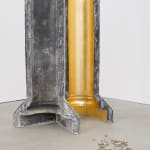Theodoulos Polyviou
Dogmatic negatives (Column I) , 2024
fiberglass, gold leaf
2 pieces, each
196.5 x 63 x 15 cm
77 3/8 x 24 3/4 x 5 7/8 in
unique
196.5 x 63 x 15 cm
77 3/8 x 24 3/4 x 5 7/8 in
unique
Further images
Dogmatic negatives (Column I), consists of a mold for casting a column, split into two halves that stand upright with a deliberate space between them to reveal the inner surface...
Dogmatic negatives (Column I), consists of a mold for casting a column, split into two halves that stand upright with a deliberate space between them to reveal the inner surface of one half, gilded in gold leaf, catching the light with a luminous warmth that recalls the Byzantine icon tradition. At the base of the molds, a small pile of rusted hardware sits, a counterpoint to the gleaming gold, invoking a sense of abandonment and decay.
The mold itself is sourced from the artist's personal archive, originally used in the construction of ecclesiastical buildings across Cyprus, including the renowned Archbishop's Palace in Nicosia. By presenting this object as a ‘dogmatic negative,’ Polyviou reflects on the hidden, inverse forms that give shape to religious structures, both physically and ideologically. The golden interior of the mold alludes to the liturgical symbolism of gilding in Christian Orthodox traditions, while simultaneously highlighting the dualities of absence and presence, spiritual reverence, and political power.
Polyviou examines the complex intersections of nationalism, religion, and identity in Cyprus during the mid-20th century. The mold's stark presentation, paired with the fragmented, corroded hardware, suggests an unresolved narrative. A so called ‘palace in exile,’ an unfinished history that mirrors the turbulent role of Cypriot churches as both a haven and antidote against colonialism, and simultaneously an oppressive structure, replicating the modes of marginalization it addresses: where spiritual authority and political aspirations become inextricably linked.
The mold itself is sourced from the artist's personal archive, originally used in the construction of ecclesiastical buildings across Cyprus, including the renowned Archbishop's Palace in Nicosia. By presenting this object as a ‘dogmatic negative,’ Polyviou reflects on the hidden, inverse forms that give shape to religious structures, both physically and ideologically. The golden interior of the mold alludes to the liturgical symbolism of gilding in Christian Orthodox traditions, while simultaneously highlighting the dualities of absence and presence, spiritual reverence, and political power.
Polyviou examines the complex intersections of nationalism, religion, and identity in Cyprus during the mid-20th century. The mold's stark presentation, paired with the fragmented, corroded hardware, suggests an unresolved narrative. A so called ‘palace in exile,’ an unfinished history that mirrors the turbulent role of Cypriot churches as both a haven and antidote against colonialism, and simultaneously an oppressive structure, replicating the modes of marginalization it addresses: where spiritual authority and political aspirations become inextricably linked.








